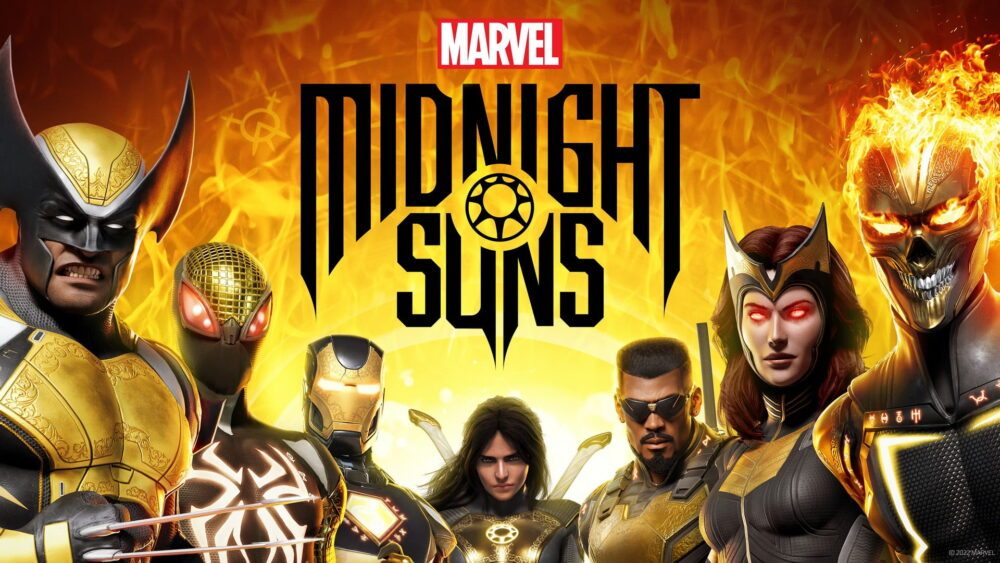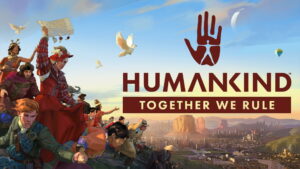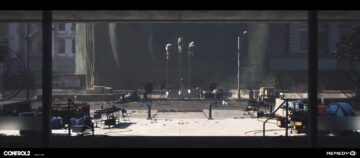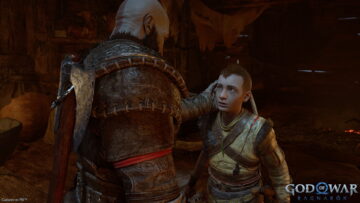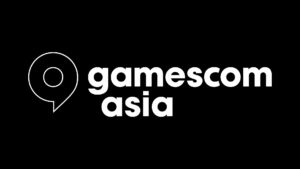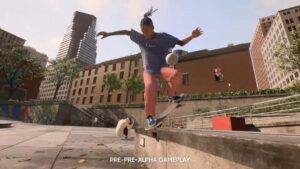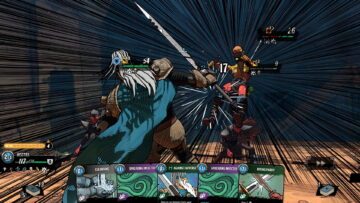If one thing Firaxis is good at, it’s making strategy games. But what about an RPG? The XCOM team is venturing into new frontiers with their latest game Marvel’s Midnight Suns. It’s a Marvel strategy-RPG with a turn-based, card-based combat system.
It sounds unappealing at first if you’re expecting an XCOM-like from the team that created that mould in the first place. Oh, it’s another Marvel game? But the XCOM combat got replaced with cards? And there are parts of the game where you control a character directly in the third-person?
So many of these gameplay elements are a stark difference from what you expect Firaxis would, and could, do.
Remarkably, Marvel’s Midnight Suns turns out to be a fantastic game. Firaxis managed to stick the three-point landing on delivering the many unproven features into a package that any fans of Marvel, strategy games and even RPG goers would end up loving.
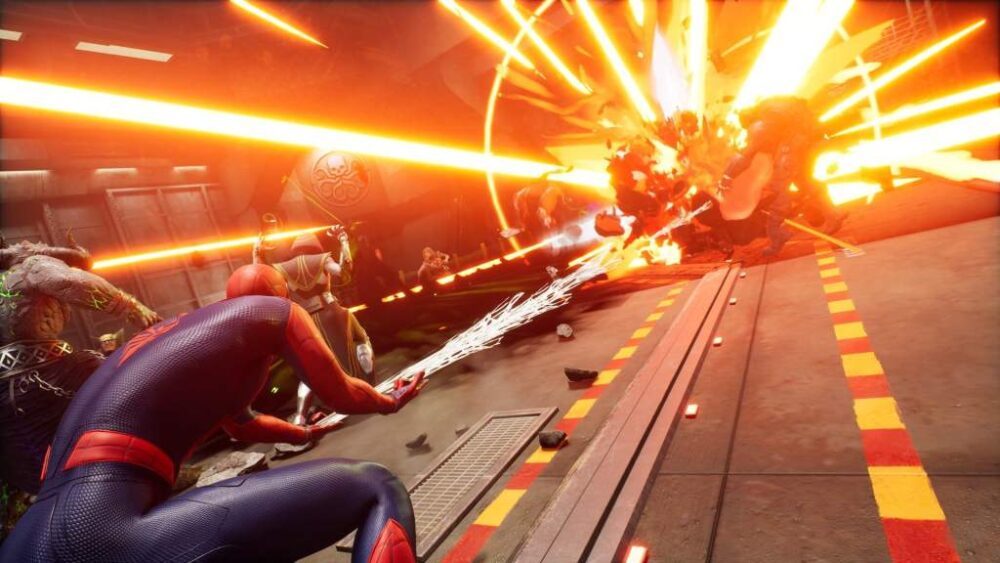
Presentation
In the right places, Midnight Suns look amazing. The superheroes in their costumes look spectacular, and they move and fight in the ways you expect them to. Captain Marvel flies when moving across the other side of the map, and explodes menacingly when she goes binary. Spider-Man (who is not a PlayStation-exclusive character thank god) swings around in style and flings rubble and crates with his sticky webs.
The animations in each attack and skill are impeccable, and while I cannot attest to how lore-accurate all the moves and gestures are (not really a Marvel guy, or a comics guy in general), but from the eyes of a normie, these heroes live up to their legend when seeing them in action.
And it’s not just the animation team, the special effects team have also went to town with their work. The arena you’re fighting in gets destroyed and trashed over the course of each turn. Each explosion leaves a mark not only as black decals but rubble piles and debris. The destruction is all cosmetic but helps sells you on how powerful the heroes, and villains, that are fighting.

There are some drawbacks to all this. There are some noticeable performance dips. You can spot them when all the effects are in full blast like during, well, a literal blast. The one fight near the end of the game in particular saw extreme performance dips on PC. And if you’re on PC, don’t bother with ray-tracing if you have a meagre RTX 2060 card, having that on tanks the framerate hard.
There is support for both AMD FSR and Nvidia DLSS on PC, which should help in clawing back performance (just don’t use photo mode when you turn on either upscaling option).
I can see why the PS4, Xbox One and Switch versions are not ready for release yet, there’s more optimisation work need doing.
It’s also a little janky. While there are no game-breaking bugs in this review build I’ve been playing, there have been some visual glitches that corrupt the textures and UI elements from time to time. And sometimes you can’t interact with interactable items because the little circle for it refuses to appear until you interact with something else. The music and voice sometimes stop playing for no clear reason. Mind the bugs. And I don’t mean Spider-Man.
But there is a patch that should be live on the game’s release, so hopefully that minor update addresses some of technical hiccups.
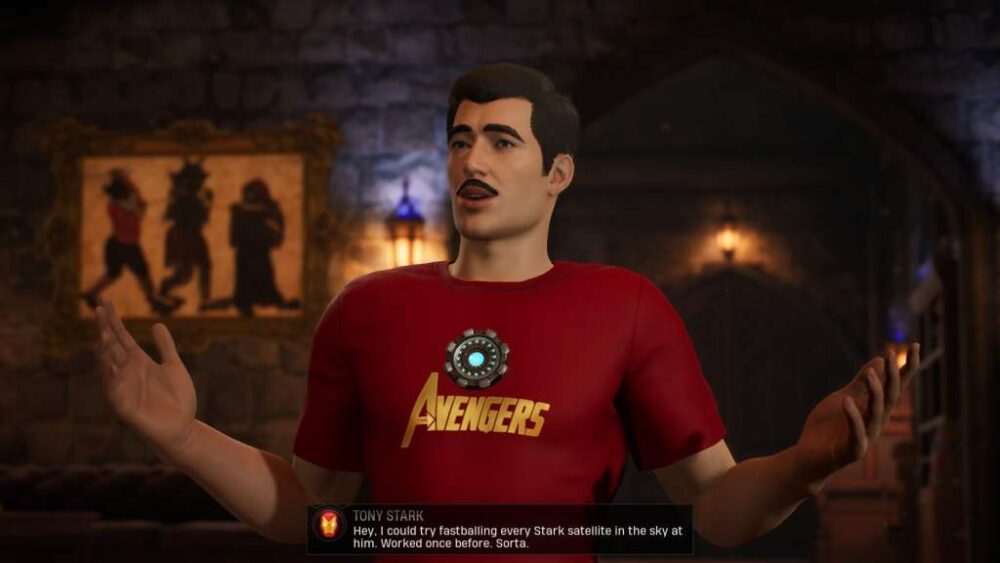
When these heroes are back at their headquarters in the Abbey and slip into something more casual, they look… okay. I think after Marvel’s Avengers folks should get used to seeing Marvel characters in games not looking like their silver screen counterparts.
Having said that, you just have to get used to the Avengers in Midnight Suns looking nothing like the ones in Marvel’s Avengers. Tony Stark here looks more like Mortimer Goth than he was Fernando Alonso there if you ask me. But that’s neither here nor there.
Though during the more casual conversations, which you are going to have a lot of in this RPG, expect to see a lot of pre-canned animations and facial expressions being used on a regular. It can’t be helped, it’s a long game after all, and this is not the first western RPG to have such issues. But it’s noticeable considering all the story intro cutscenes have bespoke animations and the combat animations look impeccable as it is.
Which is a good thing that the voice performance here hard-carries these conversation scenes. The game is fully voice acted and the voice actors have done a remarkable job of bringing these larger-than-life characters to life. You can even spot some of the bits of improv, due to the subtitles not exactly matching what is said. From the straight-edge coolness of Blade to the raspy old man that is Wolverine, each of the heroes has a strong personality, with the voice to match. Even The Hunter, who starts as a stoic fish-out-of-water person, slowly picks up on modern-day speech mannerisms and fit right in at a believable rate.

I’m quite surprised that Midnight Suns haven’t indulged in using any licenced music as other big-budget Marvel games did. With so many characters saying “mother” I would’ve expected Danzig to be playing in some missions, but no, the game uses only an original soundtrack.
And boy is the original soundtrack a banger. Yes, it uses the typical heroic orchestra but to illustrate the brooding darkness the game is themed on, the soundtrack is layered with not only light-hearted violin strings and soaring trumpets but also heavy metal guitar riffs with an onslaught of high-speed bass drum kicking.
The soundtrack is dynamic, where the tune changes based on different times of day, the different rooms of the Abbey you are in and when you begin a new turn in combat. But it also changes as the game progresses. Not only do you see visual cues on how deep in the story you have gone, but the music also gets darker (as in, the heavy metal bits start creeping in).
And you know how in XCOM there’s good pre-amble music as you set your loadout and squad that gets you hype before the start of each mission? Midnight Suns has that too, and it works just as well for this game.
And you know how Civilization games have banging opening theme music that plays in the main menu? Midnight Suns’ title theme ticks that same box Firaxis keeps ticking in their games. It’s the perfect example of how the heroic violin strings and heavy guitar riffs mesh together, just like the game’s theme. It’s… marvellous.
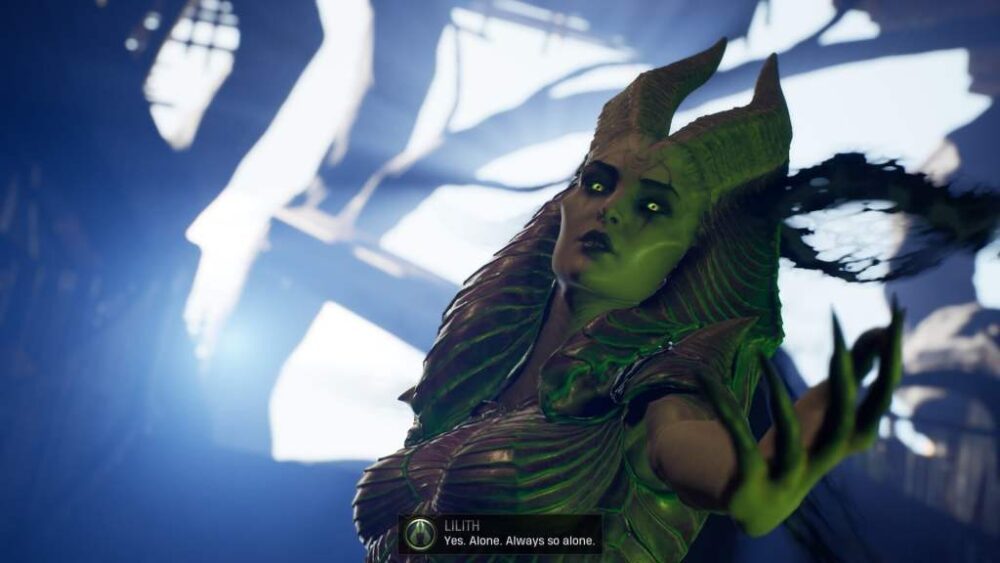
Gameplay
In Marvel’s Midnight Suns, the fascist military organisation Hydra has resurrected Lillith, the mother of demons. It’s a threat so big that even the Avengers can’t handle this alone, and the veteran team of superheroes decided to join forces with the Midnight Suns, a plucky group of young, inexperienced heroes (outside of Blade) that has a secret weapon, the only person to have ever defeated Lillith before: The Hunter. Who also happens to be a child of Lillith.
In Midnight Suns, you play as The Hunter. They are a customisable hero, though customisation is a tad limited. The two voices of Hunter are tied to the body type, you only have a number of preset faces and not full-on sliders and the wilder customisation options (like unnatural skin colours) are only found very late in the game.
Every day, you start off waking up in your (customisable) room, prepare for a mission by visiting the forge or train at the yard or send heroes on ops at C.E.N.T.R.A.L, then send a team of three heroes to do said mission, and return back home by night where you can spend the time off doing side activities. It’s the daily routine life of a superhero, housed in a spooky mansion floating in midair and suspended in a pocket dimension. While an apocalypse is looming. Normal stuff by superhero standards.
The game flow still carries that lineage of it being a game by the XCOM team. Veterans of that series can spot the uncanny similarities of the various features available, though some carry over better than others.
For example, research projects take time, but I have never seen in my playthrough where it goes over more than 1 day long. But the photobooth option that used to produce propaganda posters is now, fittingly enough, generate comic book covers.

The most contentious part of Midnight Suns during its pre-release period is actually the best aspect of the game: the card-based combat. In this game, battles are exactly that, you fight in a closed arena where you must complete objectives, such as collecting intel, capturing a Hydra agent, stopping a summoning circle or the simple “defeat all enemies”. There’s no exploration or quiet moment to set up like it was in XCOM- you’ll be jumping straight into the action.
The combat system, once you get the hang of it, is tremendously satisfying to play. There is a hint of randomness but not in the same frustrating way as missing a 90% shot at point-blank range. Rather, attacks won’t ever miss and will deal the specified damage as stated on the card, and if you see a skull icon on the enemy health bar, you’ll be sure to know that’s a confirmed K.O. hit.
But it’s not completely gone. You can try and do a ring-out on some enemies but there’s a percentage chance of it happening, for example.
Rather, the bulk of the randomness comes from what cards that are drawn into your hand each turn. But for those that feel dread or turned off by the idea of this game being a deckbuilder- it’s not like that. Every hero can only bring eight cards, and the way for a legal deck to be created has to be balanced in a way that you won’t be softlocking yourself from bringing an unuseable set of cards. So at any time, there’s a variety of 32 different cards (not counting copies thanks to other abilities). And you can bring duplicates too if you like a particular card and want to have it drawn consistently.
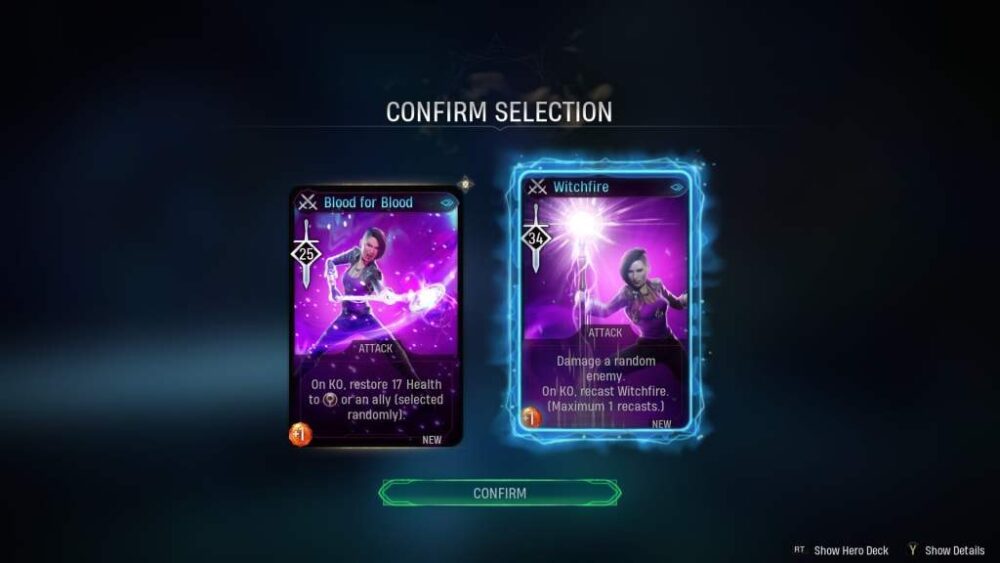
Plus, the total amount of cards per hero isn’t that big. Every hero has about 10 different cards (the Hunter has about 30 as they have three different branches of alignment), so you should be settled for a good deck quicker than you expect. Cards are only gained from gameplay.
Despite the card pack opening sequence (gamma coil analysis as it’s called in-game) looking like a loot box unlock or a gacha pull, the game will generously nudge you into unlocking new cards if they are available. Even if you don’t pick the new cards, once unlocked, you can also craft them should you need that specific card, or any other card you have unlocked so you are not beholden to RNG, thankfully.
Then what’s the point of having a gacha pull then, especially when the SSR drop is that high, you ask? Later in the game you’ll get mods, which add an extra passive to a card. You can add mods manually, but rerolling mods can get expensive, so you better get a fresh card of the same ability and then roll for the mods you want. In other words, it’s still there for the master tacticians who want to truly go in-depth and build decks. But if you want to just grab the basics it shouldn’t be a nightmare of infinite reroll.s
By presenting abilities as cards, it created room for gameplay mechanics to intersect in fascinating ways by way of the use of keywords. When you see a Quick card, you immediately know it’s good for taking out minions without wasting more resources. Knockback lets fling enemies into environment hazards, other enemies and other heroes for extra damage, or fling them into a Drop for a chance to insta-K.O. them. If the arena doesn’t have a hole, create one by playing a card with Drop.
And the cards can also be upgraded (by sacrificing a duplicate card in your inventory), unlocking more of its potential. And then you can mod them by adding a passive trait of your liking to really fine-tune it to your playstyle.

The one thing that weirded me out at first is how you don’t get to move your heroes a lot. By default, you can reposition one hero per turn. But that restriction counter-intuitively makes position much more crucial, important and meaningful. Some characters will move closer to play a card (use an ability), some move farther, some stay put. But understanding how these heroes indirectly move is another factor in figuring out the combat puzzle.
This is actually an elegant way of integrating positioning into turn-based combat games without going full strategy tactics (the next Like A Dragon game should take some notes). And this also sets it apart from other games with card-based combat.
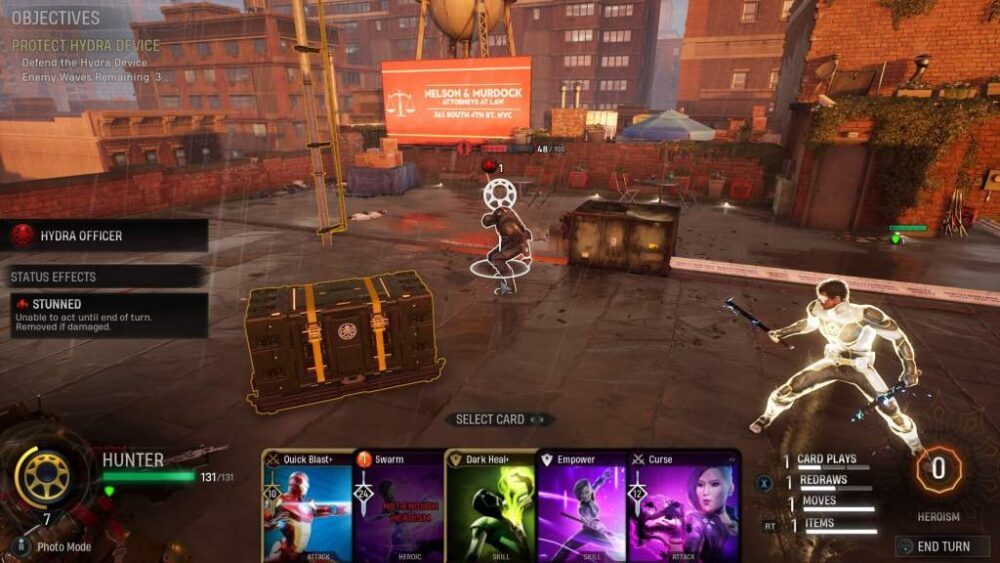
The combat will always ask you to make a meaningful decision. Each turn you have to consider all the options at play, and what’s the right game plan to fulfil your objective. Can I get everyone not targeting Doctor Strange this turn because he’ll surely get K.O.’d when you hit “end turn”? Is there a way to get to the objective in this turn, or should I use skills to prep for the next turn? Should I spend my Heroic meter now or save it? Do I even want to play this Heroic card and keep it or just redraw for something cheaper considering the situation right now?
In the XCOM games, over time you’ll figure out a safe, repeatable gameplan that you can just autoplay without thinking. The closest I ever get to that same mindset is during the opening turn of each encounter and seeing if I have an expendable Quick card or not to play immediately. Everything else from there requires some thinking and some interesting decision-making. And what’s a good game if not a series of interesting decisions?

The other fun part of Midnight Suns combat is how each hero has a specific playstyle, and it matches their established personality, character and lore. They all play differently, some easier to use than others, and provide various synergies to the team.
Nico Minoru is described to be a powerful witch that’s yet to really master wielding it. So many of her cards have Roulette which will pick one of a few choices buff/debuff/damage number etched to the card randomly.
Iron Man has quite the ego and will work extra hard to fix problems (including the ones that occur due to said ego), so he has abilities that get stronger the more you keep Iron Man cards in your hand, and the cards can get stronger by “redraw to upgrade”.
Spider-Man is nimble and his quick wits not only produce witty one-liners but also get a fighting advantage by using the environments surrounding him. This translates to him being much more efficient and stronger when using environmental hazards with many Knockback abilities to get enemies knocked into other things.
Ghost Rider’s vengeance and Hellfire come at a cost, and so he has the more complex gameplay gimmick where he deals damage to not only the enemies but himself, requiring careful play to keep him alive. And should you do, he can Lifesteal health back, increase his max HP for the fight and snowball into an unstoppable skull on fire on four wheels.
I can go on with all 13 playable heroes. The way each character’s abilities and passives are designed really helped personify these established characters, enough for even someone unfamiliar with them can see how they tick as a person.
The Hunter has to be present in all the story missions, but you can bring any three heroes on any other general missions.
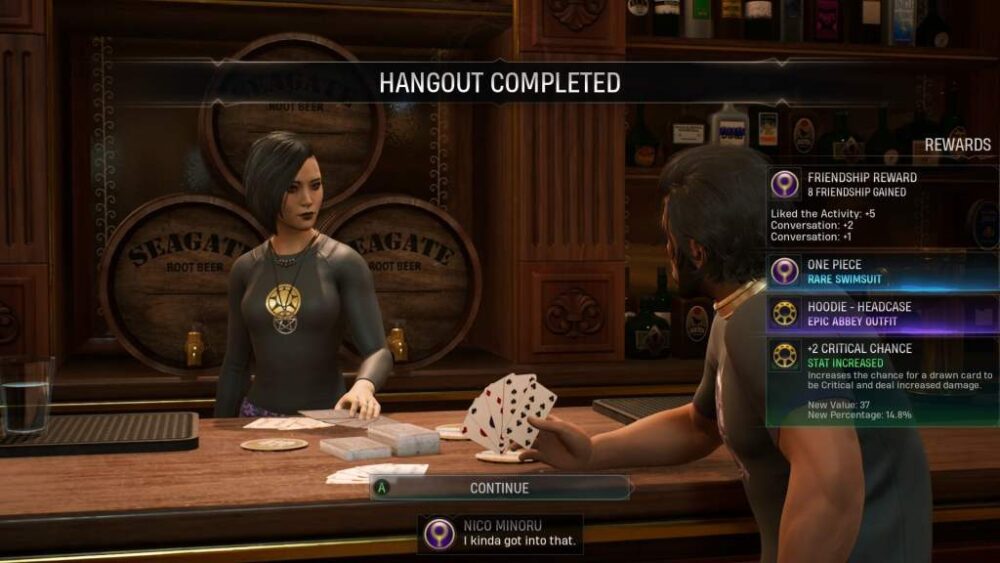
Once you’ve done the mission of the day, it’s time to kick back and relax. The downtime for Midnight Suns really sells you that it’s an RPG. That is in the way that you can hang out with the rest of the heroes and buddy up with them.
You can choose what hangout activity, some prefer working out while others like to spend the nights playing video games. Or go a bit meta by passing the time with a game of cards. Or you know, go fishing in the middle of the night for some reason (it is an RPG when you have some form of fishing).
You have a little conversation with the hero you’re hanging out with. And it can be serious, like the current Ghost Rider Robbie Reyes struggling with impostor syndrome, or it can be silly like Blade’s hot take on vampire movies. How you respond to the conversations, including the ones outside of the hangouts, can lead to them liking you a bit more (heart goes +1, +2) or less (only by -1).
The conversations thankfully are nuanced. Sure there is an alignment system where you can lean on the light side or embrace the dark side, but it’s no Paragon versus Renegade binary choice. You can be Balanced by switching up between light and dark responses, and there’s always a neutral option.
Responding to conversations is tricky in a good way. Sure, Iron Man likes it if you heap him in praise or bring your own side of snarkiness, but not all choices with “[Joke]” at the start of the sentence are the ones that raise the relationship meter. He scolded me once for not reading the room. Captain Marvel appreciates a little support but will definitely not like it if you go “Hunter-splaining” on her to do her job.
But it’s fine. Even the heroes butt heads among themselves, so even if you feel like you’re not optimising the conversation since the hearts didn’t pop up, the writing for the responses is worth experiencing. Plus, you can go give gifts or invite them to havens or train with them or bring them alongside Hunter on missions that boost more of that relationship. A -1 makes barely a dent in progressing the relationship meter.
And you want to boost that relationship to the max. Not only for the nice relationship level-up scenes, but there are gameplay incentives like unlocking passive abilities and their most powerful card ability if you max it out.

Content
Marvel’s Midnight Suns will take about 60 hours to complete, which is par for the course for an RPG. And as you can imagine, the playtime is long due to how it takes time in moving the story forward, letting you immerse in the world, get to know the team of heroes that fight alongside you and get them prepped with the right training and abilities. I finished my playthrough at 70 hours time.
There’s a whole optional chain of side-quest where you can explore the Abbey grounds for secrets, collectibles and more cosmetic unlocks. It gives reason to why you can navigate the place in the third-person, something you can’t do in missions. It’s quite substantial in length and worth doing for the extra bit of lore on your little hideout. Though you can totally skip it.
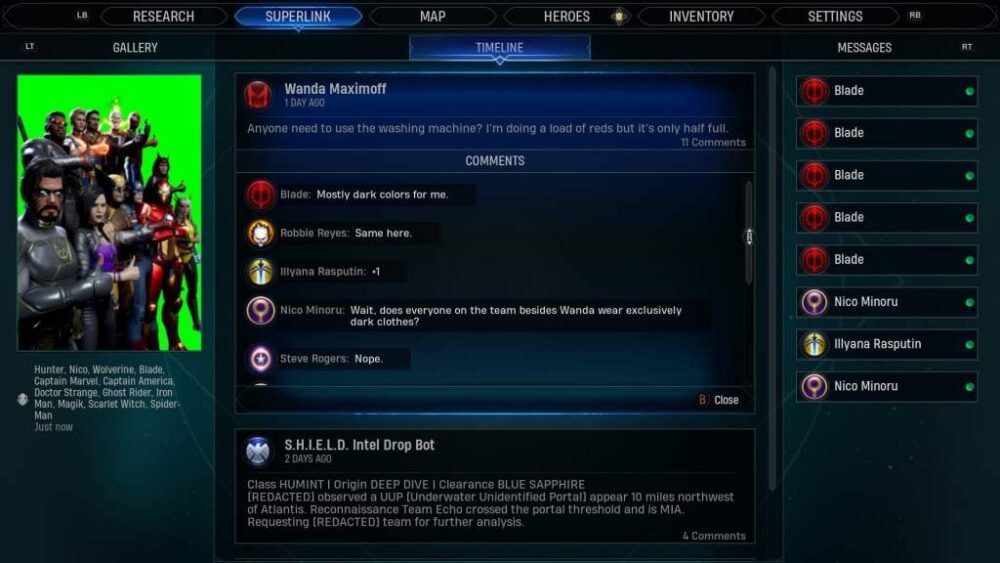
Story-wise, it splits into three acts. The first act, as we described in our first impressions, will have a lot of Marvel-style comic-book quips, one-liners and jokes. This can be either off-putting or silly fun depending on your tolerance towards this style of writing. But over time, you get to see the more serious plot lines develop.
The story isn’t going to win awards for originality, but it wins in its delivery. Towards the long runtime, every hero gets their time to shine. A few of them have side plots you can discover. Everyone will tell you their origin story and reveal their intimate secrets if you befriend them to max level. There are so many fun shenanigans that the team is up to in the downtime.
There’s good banter being thrown around, and it’s cool to see how these heroes not only build relationships with you but build with each other. Find the bros hanging out playing video games. Uncover a romantic subplot developing (you can’t romance anyone, but seeing some of them developing feelings with each other is cute). See co-workers that irritate each other yet somehow can still work together and produce wonders. Learn life lessons from the elder statesmen of the team, and provide advice to those younger than you. And there’s the group chat on Superlink (think Facebook but for superheroes) where you can see the banter of different personalities and of different age groups.
As much as I cringe in the early bits of Midnight Suns, the writing definitely grew over time and the attempt at quippy humour becomes more tolerable as an aside from the serious, looming apocalypse you and the team must stop. There’s a lot of heart to its writing that will make you care and understand the characters that you bring to battle. And you don’t need to be a Marvel die-hard to do so.
In how the story is written, it rivals the best of JRPGs where you save the world via the power of friendship. Midnight Suns is up there among the Fire Emblem and Persona series of games, just as it can hang together with the Mass Effect and Dragon Age franchises.

The missions are replayable, and you can unlock harder difficulties over the course of the story campaign should you wish to test your strategy skills further (and gain more rewards). There’s a good number of mission variety, but the maps do get repetitive. Thankfully, the combat system doesn’t get stale, you’re always playing the cards a little differently every time so replayability is still good.
Once you completed the game, you can begin New Game+, or keep playing in the post-game to find all the collectibles and max out your relationships.
Interestingly, we can already expect four more heroes to be added to the Season Pass. I am thoroughly confident in the writing team breaking the 4th wall into pieces when Deadpool joins. Though I hope these DLC characters have a relationship meter. The last unlockable hero is unlocked so late in the game that they don’t have a relationship meter, which is a shame if this continues with the DLC characters. Let me go fishing with Morbius, please.
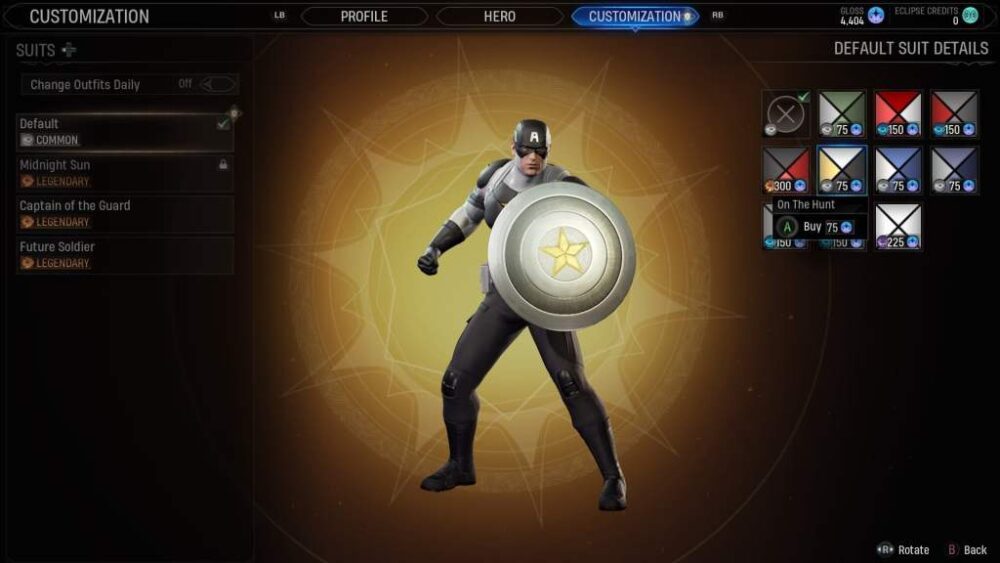
There are plenty of cosmetics to unlock. It’s a little annoying as you don’t see all the unlockable outfits and colour palettes, they only appear once you unlock them by opening chests scattered around the Abbey or complete hangouts with the heroes. These include new casual outfits for Hunter and the heroes and even swimsuits.
Then you need to spend in-game currency, Gloss, to properly unlock them. But with how long you’ll be playing the game, the drip feed rate is fine. You should get around 100 Gloss per mission on Normal, and the most expensive colour palette I’ve seen is at 300 Gloss.

Note that while you can unlock different outfits for you and the heroes to wear in the Abbey, combat outfits are limited. Hunter gets a few unlockable combat outfits, but for the rest of the heroes, you’ll only unlock the Midnight Suns one.
At launch, the heroes (outside of Hunter) get two extra outfits each, but you have to purchase them at the Marketplace (which uses a premium currency) or purchase the more expensive versions of the game. I expect new costumes will be added over time, and it’s likely most of them will cost extra.
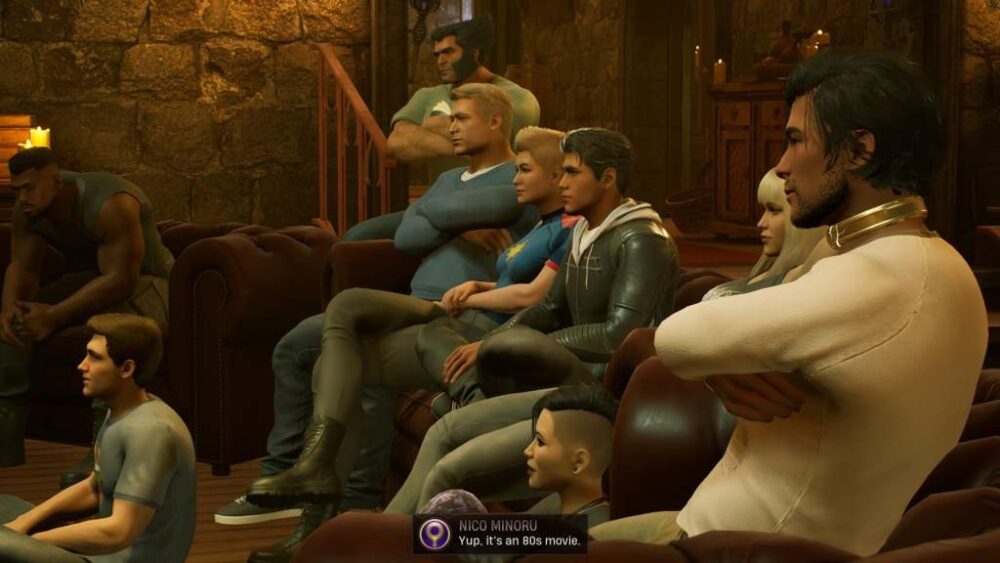
Personal Enjoyment
I am playing Marvel’s Midnight Suns from the perspective of a fan of Firaxis games that’s not really a fan of Marvel, tried the many recent crops of Marvel games but don’t seem to enjoy them as much, and someone who actively avoids card games. So I came into playing the game with low expectations of even liking it.
So it does come as a surprise that I wholeheartedly enjoyed my 70 hours with Midnight Suns. Maybe it’s the low expectations, but everything just clicks. The tactical combat is fun and satisfying, the deckbuilding is lean and not overwhelming, the writing is fun and engaging, and the occasional jank and bugs are not game-breaking, only slightly annoying.
It’s probably also because I haven’t played an RPG in a while. And Midnight Suns filled that craving for me. I’m a sucker for a mishmash team of people saving the world via the power of friendship, and this story of an unlikely bunch in an unlikely team-up definitely fits the bill.
I’m enjoying the cheeky pop culture references, but I think Marvel fans will love the many deep cuts and references this game has. It’s also interesting that Marvel comics exist in-universe so you do get to see relevant comic book covers that die-hards will recognise and love.
It’s also the only Marvel game thus far that, to my knowledge, acknowledges the many aspects of the Marvel universe outside of what’s on the game title. So many heroes and villains have a passing mention in Midnight Suns, indicating that should the game becomes a franchise, all bets are off. Anyone can appear in this spooky adventure.

Verdict
Marvel’s Midnight Suns combines the best elements of a modern RPG and its own unique brand of card-based combat to create a compelling strategy-RPG unlike any other.
It’s a treat for Marvel fans with its many deep cuts that got a spotlight alongside the more popular aspects of the universe. The card-based combat system delivers the power fantasy of being a powerful superhero but still grounding it into a game of tactical strategy. The writing is good enough to let you build friendships with the cast of characters, all delivered with stellar voice-acting performances.
What it’s being let down is in its many technical issues and worries of over-monetising an already premium game. Each of these can still be addressed post-launch, but are valid concerns should you wish to stay on the fence for a bit.
As it stands right now, Marvel’s Midnight Suns has proven Firaxis can step up above and beyond its comfortable niche in strategy games. And just like what they did to XCOM, they have successfully reinvented a cult hit series by bringing their own twist- and you know it from the minor spelling change in the title.
Played on PC. Review code provided by the publisher
Marvel’s Midnight Suns
Marvel’s Midnight Suns combines the best elements of a modern RPG and its own unique brand of card-based combat to create a compelling strategy-RPG unlike any other.
-
Presentation 7.5
-
Gameplay 10
-
Content 9
-
Personal Enjoyment 10
- 2K
- amazon prime gaming
- axie infinity
- Casino Games
- coin genius
- EA Sports
- Evil Geniuses
- Firaxis
- Gamer Matters
- Gaming
- gaming headset
- gaming pc
- madden nfl
- Marvel
- Marvel's Midnight Suns
- Nintendo
- Online casino games
- pc games
- plato
- plato ai
- plato data intelligence
- plato game
- plato gaming
- platodata
- platogaming
- playstation
- prime gaming
- review
- Team SoloMid
- xbox
- zephyrnet
